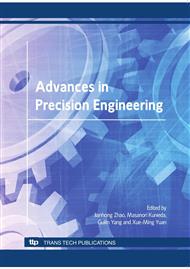p.381
p.386
p.391
p.396
p.401
p.406
p.412
p.417
p.422
Feasibility Study on Producing Components with Embedded Channel by Powder Injection Moulding
Abstract:
Feasibility study on producing components with embedded channel by powder injection moulding (PIM) is conducted in this paper. The base plate with open channel was produced by co-injection moulding of polymeric material and ceramic feedstock. The polymeric material acted as the sacrificial material to fill the channel feature. A cover plate was then over-moulded onto the base plate to form green assembly, which was then debinded and sintered. The embedded channel was created when the sacrificial material was removed during the debinding and sintering stage. This process eliminates the need for additional joining process required by conventional manufacturing process which could cause misalignment and leakage under harsh working environment such as high pressure and high temperature. Joining was found between the cover plate and the base plate in over-moulding stage. Temperature and time during solvent debinding played important roles in order to obtain defect free component. Low temperature and short time in solvent debinding resulted in insufficient wax loss which led to various types of defects. A fair good sintered component was obtained under optimal debinding condition at 50 °C for 48 hours. The embedded channel was observed clearly by x-ray inspection without blockage by foreign particles. The shape of the channel was well retained and perfect bonding was formed in the central area of the two plates.
Info:
Periodical:
Pages:
401-405
Citation:
Online since:
September 2010
Authors:
Price:
Сopyright:
© 2010 Trans Tech Publications Ltd. All Rights Reserved
Share:
Citation:


